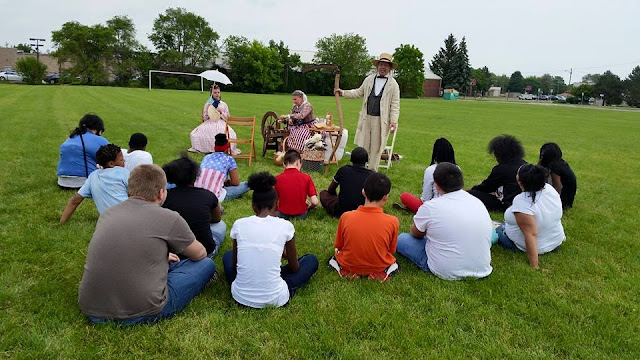The following is a true conversation that actually occurred only a few months ago:
Person: "Why do you do that, get all dressed in those old clothes and pretend like you live in the past? Why don't you act like an adult instead of a little kid?"
Me: "And how does my reenacting affect you in any way?"
Person: "It doesn't. But do you know how ridiculous you look?"
Me: "And what does it matter to you what I do?"
Person: What does your wife think of you doing this?"
Me: "You mean, the one who dresses up in a hoop skirt and brings her spinning wheel to the reenactments? She thinks it's fine,"
Person: "You're impossible!"
Yeah...this person actually got angry because I could not be convinced that what I was doing was childish.
Yeah...heh heh...I gotta laugh...
Anyhow, one of the points during this discussion I did not tell you is how well we can teach history to kids by role-playing...through living history, and how we can bring the past to life and make what could be an otherwise boring subject into something interesting.
Well, in the space of just one week a few of us had two opportunities to do just that.
The first one took place at a local Middle School for the 8th graders who were studying the Civil War.
We've been doing presentations for East Detroit Public Schools for about a decade now and consider it one of our many annual highlights.
And the weather has been with us for all but one year!
For these school presentations we divide ourselves into multiple groups, or stations. The kids, usually in groups of anywhere from 10 to 20 or so, will visit the military station first, where they will learn of the life of a Civil War soldier, including their uniforms, their guns, and of camp and battle life. And because the school will work with us (as well as the police and neighbors), the guys get to fire their muskets for the kids, which usually result in screams, laughs, startled jumps, giggles, and one or two of the young teens falling down, acting as if they've been shot dead.
Tell you what, here are a number of pictures taken at the Kelly Middle School presentation (followed by another kids history lesson).
I think you'll see how we can entice these 8th graders into loving what could be just another plain old school lesson:
 |
| Here is the 21st Michigan soldier's camp - right next to Kelly Middle School. |
 |
| The kids, especially the boys, loved the military demonstration. |
 |
| Kids loved to be dressed up in uniform, plus it takes that extra step to engulf the student into the past. (Picture courtesy of East Detroit Public Schools) |
 |
| Of course, firing the muskets is always the favorite part for the school kids. |
 |
| Over in the civilian area we had a telegraph operator who brought along a period telegraph machine. |
 |
| Mrs. Robeck allowed the children to tap out a message on the ancient communication device. (Picture courtesy of East Detroit Public Schools) |
 |
| Joining us in this presentation was our resident tintype photographer, Robert Beech. (Picture courtesy of East Detroit Public Schools) |
 |
| And here I am with my wife and daughter. We showed the kids a bit about farm life. (Picture courtesy of East Detroit Public Schools) |
 |
| The kids - girls especially - were very interested to see my wife spin on her spinning wheel. |
 |
| I spoke to the kids about farm chores. (Picture courtesy of East Detroit Public Schools) |
Next up, me and a few other living historians traveled to the Plymouth Historical Museum to help with their "A Night at the Museum," event, based on the movies of the same name. This is where a group of children will go into the meeting room and eat dinner and watch one of the "Night at the Museum" movies. When the movie is over, the museum director will go downstairs with the Museum's "Tablet of Akmenrah" and invite the kids to come upstairs and see what happens with the tablet. Those that have seen the movie know that the tablet makes the mannequins in the movie come to life. So, when the tablet comes upstairs, the living historians (as mannequins) will come to life and interact with the kids.
On this Wednesday evening, a group of around a dozen Girl Scouts chose to have a history party, and here are the results:
 |
| Meet Amelia Earhart, the infamous female aviator from the 1930s. This was this young lady's first experience in the world of living history presentation, and she did a fine job |
And to my friend who thinks I am an immature nut, I just smile and nod. I mean, why should kids have all the fun, right?
By the way, if you are interested in how I taught my own children about history, check out this post:Raising Your Kids In History
Until next time, see you in time.
.









1 comment:
Those kids will remember the experience you gave them long after they have forgotten all the answers to all of the tests.
Post a Comment